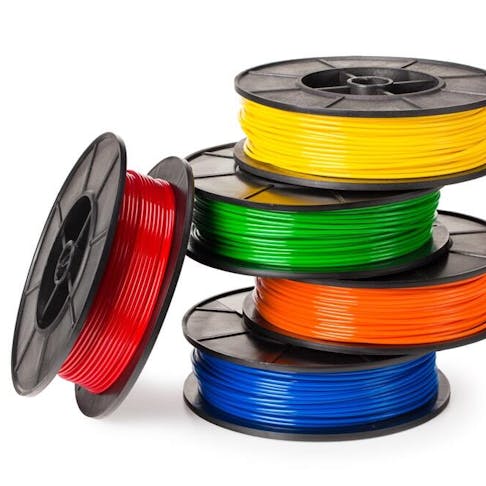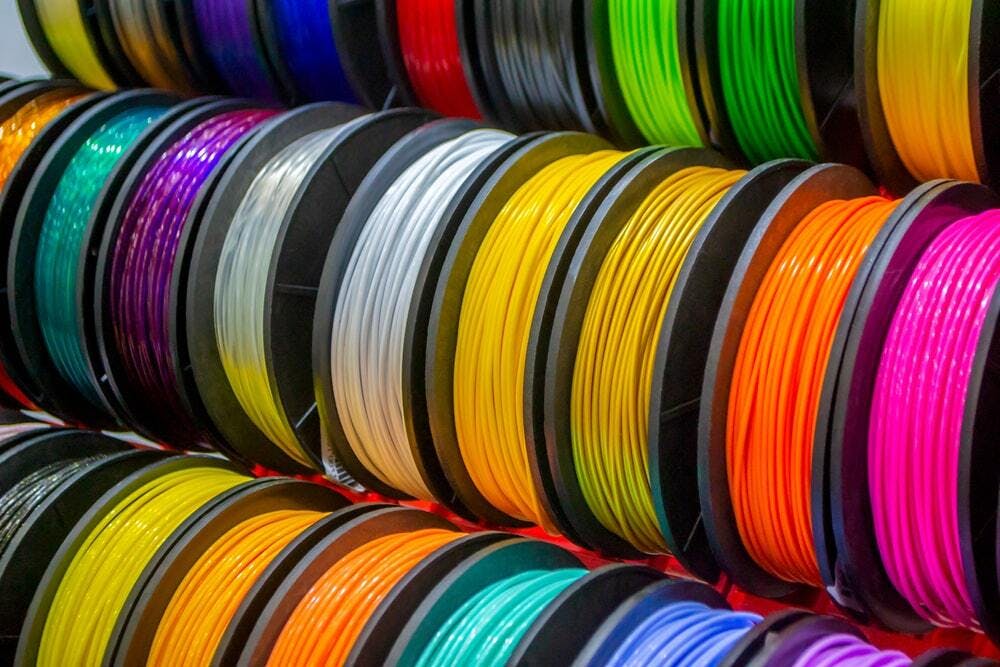
All About ABS 3D Printing Filament: Materials, Properties, Definition
Learn more about ABS 3D printing filament and how to use it.

ABS (acrylonitrile butadiene styrene) is probably the most common filament used in 3D printing. It is especially valuable in strong plastic parts that must remain resilient in the face of temperature swings. It is mainly used in FDM (fused deposition modeling) 3D printers. ABS is a thermoplastic polymer composed of three monomers: acrylonitrile, butadiene, and styrene. The material was first patented in the 1940s and very quickly gained popularity.
ABS is used in many industries today because of its flexibility, moldability, and strength. You can find it in such varied products as Lego toys, home appliances, and piping systems. Compared to most inexpensive polymers, ABS is quite flexible, resists high temperatures, and can easily be machined. In the realm of 3D printing, it is valued because it prints quickly and is more durable than many other options. This article will define ABS 3D printing filament, examine its composition and properties, and compare it to other 3D printing filaments.
What is ABS 3D Printing?
ABS is one of many polymer filaments that FDM and FFF printers can employ. At the proper temperature, it is easy to mold into nearly any shape. ABS solidifies evenly and cures without any post-processing. Users tend to choose it for its relatively high-temperature resistance and flexibility.
What is the Composition of ABS Filament?
ABS is a copolymer composed of three monomers. It is made by polymerizing acrylonitrile and styrene in the presence of butadiene. Acrylonitrile gives it rigidity, chemical resistance, and strength. Styrene provides a smooth and shiny texture. And butadiene is the rubbery component that makes ABS tough. Figure 1 below is an example of an ABS filament:
Multicolored ABS filament for 3D printing.
Image Credit: Shutterstock.com/MarinaGrigorivna
What Are the Properties of ABS Filament?
ABS filament is a commonly used filament for general-purpose printing. Listed below are some of its properties:
- Has high heat tolerance that can withstand hot temperatures.
- ABS-printed parts are extra tough and can survive multiple impacts. It has good impact resistance even at low temperatures.
- ABS filaments have a superior melt flow.
- Good abrasion and strain resistance.
For more information, see our guide on what is ABS.
Comparison of ABS Filament Properties
Table 1 lists and compares the properties of ABS, PLA (Polylactic Acid), and PETG (Polyethylene Terephthalate Glycol):
| Properties | ABS | PLA | PETG |
|---|---|---|---|
Properties Impact strength | ABS 200-215 J/m | PLA 26 J/m | PETG 101 J/m |
Properties UV resistance | ABS Average | PLA Average | PETG Better than average |
Properties Density | ABS 1.03-1.14 g/mL | PLA 1.24 g/mL | PETG 1.27 g/mL |
Properties Thermal conductivity | ABS 0.17- 0.23 W/mK | PLA 0.111 W/mK | PETG 0.21 W/mK |
Properties Elongation at break | ABS 10-50% | PLA 7% | PETG 130% |
Properties Yield strength | ABS 2.96-48 MPa | PLA 70 MPa | PETG 50 MPa |
Properties Flexural strength | ABS 2400 MPa | PLA 106 MPa | PETG 70 MPa |
Properties Hardness shore D | ABS 100 | PLA 88 | PETG 106 |
Properties Tensile strength | ABS 2.96-43 MPa | PLA 59 MPa | PETG 53 MPa |
Properties Specific heat capacity | ABS 1.60-2.13 kJ/(kg·K) | PLA 1.590 kJ/(kg·K) | PETG 1.30 kJ/(kg·K) |
Properties Young modulus | ABS 1.79-3.2 GPa | PLA 3.5 GPa | PETG 2.1 GPa |
What Are the Limitations of 3D Printing with ABS?
The shortcomings of 3D printing with ABS (acrylonitrile butadiene styrene) are:
- It releases toxic, foul-smelling volatile organic compounds (VOCs) while printing.
- Printed parts are prone to warping. This is caused by uneven temperature distribution during printing when the layers cool faster before binding with the next layer underneath.
- ABS becomes discolored and often brittle under prolonged exposure to UV radiation. It thus is not well suited to outdoor applications.
The strengths of ABS, however, are:
- It has good mechanical properties that make it strong, durable, and reliable.
- The interface lines between printed layers can easily be removed using acetone.
- Compared to other materials with similar moldability, flexibility, and mechanical strength, ABS is very affordable.
- It can withstand high temperatures compared to most inexpensive thermoplastics.
Why is ABS Used in 3D printing?
ABS is used in 3D printing because of its resistance to impacts and high temperatures. ABS 3D printer filament comes in many colors and allows for smooth and shiny finishes.
How to Use ABS in 3D Printing
Printing with ABS can be difficult if not well managed. Below are some tips and tricks to remember:
- Place the printer in a room with a consistent temperature. Turn the printer’s fan down (or completely off) because it can create an uneven temperature distribution that may impact the print. Do not try to accelerate the plastic’s cooling process.
- Use adhesion glue on the printing bed before initiating the print. If your bed plate can be heated, set it to between 90°C and 110°C. The temperature and glue will help prevent warping, premature separation, and other printing inaccuracies.
- Keep printing speed low so that each layer can cool before receiving the next one. The corners on improperly cooled prints tend to lift and separate. Maintain a speed of 30 mm/s at the beginning of the print and do not exceed 50-60 mm/s.
- ABS is a hygroscopic material, meaning it can absorb moisture from the air. It is important to store ABS filament in an airtight container.
| Printer Settings | Value |
|---|---|
Printer Settings Extruder temperature | Value 230-250°C |
Printer Settings Bed temperature | Value 95-110°C |
Printer Settings Nozzle Temperature | Value 210-250°C |
Printer Settings Print speed | Value 30-60 mm/sec |
Printer Settings Extruder fan speed | Value Leave the fan off for the first layer. Set it no higher than 30% of maximum speed thereafter. |
Printer Settings Retraction speed | Value 25 mm/sec |
Printer Settings Retraction distance | Value 3-6 mm |
Printer Settings Layer height | Value 0.1-0.2 mm |
Printer Settings Print temperature | Value 220-245°C |
Printer Settings Bed material | Value Glass with glue |
The printer settings may vary depending on the brand used. It is recommended to check the manufacturer’s datasheet.
What is the Best ABS 3D Print Speed?
Most experts recommend a print speed between 30 and 60 mm/s for the body of the part. The goal is to balance speed against the material’s need to cool properly. Printing too quickly may result in warped parts.
What is the Melting Temperature of ABS Filament?
The melting temperature of ABS filament is generally between 210-250°C. It is recommended to check the manufacturer’s data sheet for the specific melt temperature of their filament.
Is a Heated Printing Bed Required when Printing with ABS?
Yes, a heated bed is required during ABS printing. The warmth prevents it from cooling too rapidly and warping or peeling away from the bed.
What is a Good Wall Thickness for 3D Printing ABS?
Even if your part needs to be flexible, it’s best not to print walls thinner than 1.5 mm. Thin walls limit the amount of raw material your part requires and speeds up the printing process.
What is a Good Wall Density for 3D Printing ABS?
The infill density requirement is based on the part application. For ABS-printed parts, the recommended infill density is 20-50%.
Is ABS Biodegradable?
No, ABS is a non-biodegradable plastic. It has a pungent smell and emits toxic chemicals when melted.
Is ABS Recyclable?
Yes, ABS can be recycled. Recycled ABS is often made into sheets, show trays, car parts, and ABS pipes.
Is ABS Hygroscopic?
Yes, ABS is hygroscopic and can easily absorb water.
What is the Difference Between ABS and PLA in 3D Printing?
ABS is a non-biodegradable thermoplastic. It is used for printing end-use parts, casings, and functional prototypes. PLA (polylactic acid), on the other hand, is made from biodegradable materials like corn starch. It is used to print fast projects like showcase models and rapid prototypes. ABS is much stiffer, more resilient under high temperatures, and does not break as easily as PLA. For more information, see our guide on PLA vs. ABS 3D Printing.
What is the Difference between ABS and PLA+ in 3D Printing?
PLA+ is an enhanced version of PLA. It has the same fundamental composition as PLA but includes extra additives. PLA+ is made from biodegradable materials, while ABS is non-biodegradable. PLA+ has a narrower printing temperature range (200-230°C) compared to ABS (210-250°C). It also produces higher quality print finishes than ABS.
What is the Difference between PETG and ABS in 3D Printing?
ABS is a thermoplastic polymer, while PETG (polyethylene terephthalate with glycol) is an adaptation from PET. Glycol is added to modify its chemical properties for better strength and durability. ABS withstands heat up to 100°C and can be damaged when exposed to UV rays for a long period. PETG’s heat resistance tops out at 80°C, but it is a good fit for outdoor applications due to its high UV resistance. For more information, see our guide on ABS vs. PETG 3D Printing.
Summary
This article presented ABS 3D printing filament, explained what it is, and discussed all factors to consider when using this filament. To learn more about ABS 3D printing filament, contact a Xometry representative.
Xometry provides a wide range of manufacturing capabilities, including 3D printing and other value-added services for all of your prototyping and production needs. Visit our website to learn more or to request a free, no-obligation quote.
Disclaimer
The content appearing on this webpage is for informational purposes only. Xometry makes no representation or warranty of any kind, be it expressed or implied, as to the accuracy, completeness, or validity of the information. Any performance parameters, geometric tolerances, specific design features, quality and types of materials, or processes should not be inferred to represent what will be delivered by third-party suppliers or manufacturers through Xometry’s network. Buyers seeking quotes for parts are responsible for defining the specific requirements for those parts. Please refer to our terms and conditions for more information.

